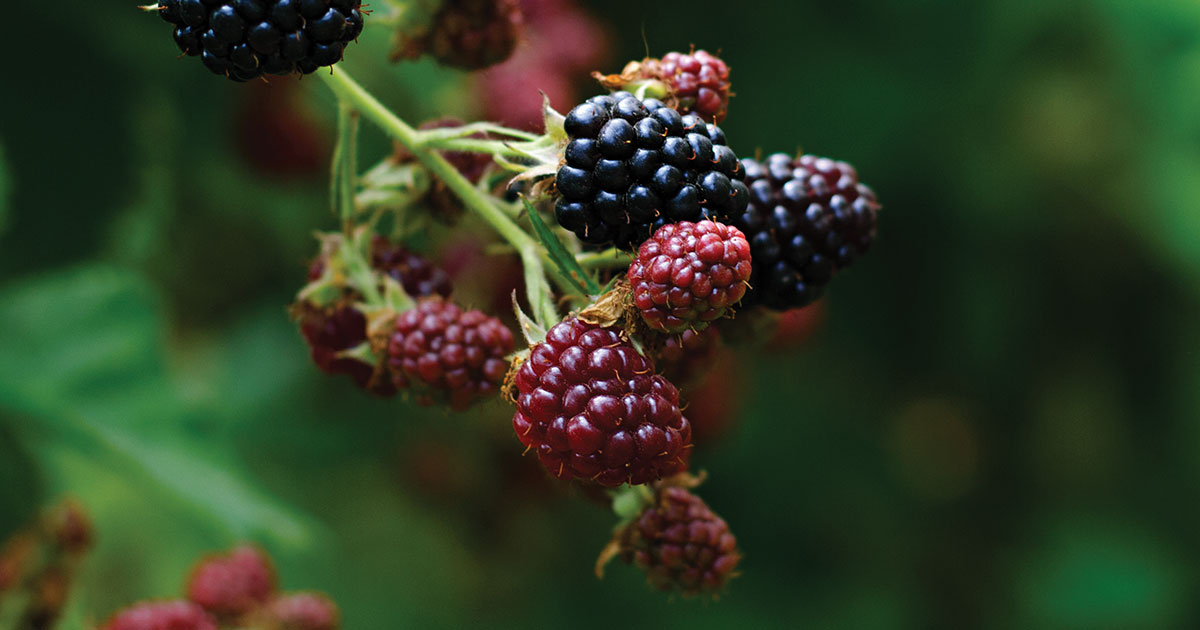Along back roads, walking trails, and woods, and close to home in your backyard is the fruit of temptation. Whether you know its name or not, coming across a plant with wild fruit invites two questions: “What is it?” and, “Is it safe to eat?” Knowing the identifying properties of common and poisonous berries continues to be a useful skill. While technology has boosted awareness of plants through apps, the golden rule still stands: “Never eat anything that you cannot identify.” Let us begin by focusing on safe native wild berries and plants.
Blackberries: Many wild berries are not safe to eat; however, wild blackberries, strawberries, and blueberries are both recognizable and safe. The distinct characteristic of the blackberry is the broad, jagged green leaves and red branches. Berries ripen in August and offer strong antiviral properties. They are great for a sweet snack or made into jams, jellies, preserves, cobblers, pies, and wine. Watch out for the thorns!
Tip: Do NOT believe a berry is safe if you see an animal eating it.
Dandelion: Turn the bright yellow flowers immersed in your green lawn to an advantage. High in vitamins A and C, and beta carotene, dandelions can be eaten raw, cooked, or brewed to make dandelion wine. Surprisingly, dandelions are rich in vitamin A and nutrients such as calcium, protein, and magnesium.
Daylilies: The most common, safe, wild daylily is bright orange, leafless, and possesses flowers with six petals. Unlike the tiger lilies or Easter lilies that are toxic, the shoots of the daylily are safe, whether raw or cooked. Just slice the six-inch sprouts of the plant right above the soil level; they will regenerate from the roots in early spring. Chop and add to a stir-fry or pasta meal.
Elderberries: As a member of the honeysuckle family, wild elderberries are a culinary delight and a medicinal secret, soothing flulike symptoms. Eating them raw is not wise; however, cooked, the berries are safe to add in desserts. As a shrub extending to ten feet in height, it has seven main long, round leaves with jagged edges. The flower blossoms in Spring and produces clusters of white flowers often resembling an umbrella. The harvest occurs in late summer as the flowers turn dark purple and begin to droop. Remember, ONLY the flowers and berries are edible! (Consider planting an elderberry shrub in your yard!)
Grapevine Water: Growing near riverbanks, wild grapevines are a thirsty forager’s most significant find. Including the grapes and the leaves, even the contents within the vine are safe to consume. Cut through one end of a vine, and be prepared to fill a container with grapevine water, a pure, viable source of water discovered by the Native Americans.
Muscadines: It is essential to recognize the characteristics of a safe plant. Moonseeds, for instance, while native, are TOXIC and are similar in appearance to a grapevine. The shape of the leaves is one distinct feature; the Moonseed vine does not have zig-zagging edges like the muscadine. It also possesses a non-peeling bark. Once the blackish-purple muscadine grapes appear, it is time to harvest.
Harvesting Responsibly:
Another rule of thumb is only to take what you need. Do not strip a wild plant. You are not the only one who may find it useful. Remember, the insect and bee population, as well as birds, may thrive on its nectar. Additionally, make sure the plant can thrive once you have gone.
Take an Interest in Unknown Plants
If you enjoy leisure walking trails surrounded by nature’s natural flora, consider carrying a pair of small pruning shears or scissors, a paper bag, and a breathe-through bag, such as one of burlap, to contain samples. Taking a few pictures of the full plant or shrub, the leaves, the stems, and flowers will also aid in the mystery of identification. Beyond foraging for fruit, roots, leaves, and plants, mere curiosity can support your knowledge; therefore, look around perhaps up trees, and especially straight down. It’s a special moment when you can share honeysuckle or wild strawberries with a like-minded and curious friend or child. He or she will be eager to learn the useful skill of foraging and become more aware of native plants.






















